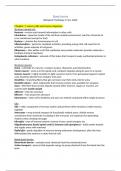Book terms
Biological Psychology 13 ed., Kalat
Chapter 1: nerve cells and nerve impulses
Structure animal cell:
Neurons = receive and transmit information to other cells
Membrane = separates inside of the cell from outside environment, hard for chemicals to
cross membrane (except for fuel).
Nucleus = contains the chromosomes in cell
Mitochondrion = performs metabolic activities, providing energy that cell needs for its
activities, genes separate of cell genes
Ribosomes = sites within a cell that synthesize new protein molecules (protein molecules =
facilitate chemical reactions)
Endoplasmic reticulum = network of thin tubes that transport newly synthesized proteins to
other locations
Structure neuron:
Soma = cell body of a neuron, contains nucleus, ribosomes and mitochondria
Motor neuron = soma is in the spinal cord, conducts impulses along its axon to a muscle
Sensory neuron = highly sensitive to light, sound or touch, from perceptual organs to spinal
cord, branches directly from receptor into axon
Dendrites = branching fibres that get narrower near their ends, tied to soma
Dendritic spines = short outgrowths that increase surface area available for synapses
Axon = thin fibre that conveys impulse toward other neurons, organs or muscles, are
covered with myelin sheath
Afferent = info into structure
Efferent = info away from structure
Interneuron = when cell’s dendrites and axon are entirely contained within single structure
Glia:
Glia = other component of nervous system and performs other functions, holds neurons
together
Astrocytes = wrap around synapses of functionally related axons, shields neuron
connections from chemicals circulating in the surround, are important for generating
rhythms when sending messages
Microglia = part of immune system: remove viruses, weak synapses etc.
Oligodendrocytes (brain/spinal cord) & Schwann cells (periphery) = build myelin sheaths
and supply axons with nutrients
Radial glia = guide migration of neurons during embryonic development, after this they
differentiate into neurons or other kind of cells
Blood-brain barrier:
Blood-brain barrier = excludes most chemicals from the vertebrate brain
Active transport = process that expends energy to pump chemicals from the blood into the
brain
,Nourishment of vertebrate neurons:
Glucose = main nutrient of neurons, only nutrient that crosses BB barrier in large numbers
Thiamine = needed to use glucose, deficiency often caused by chronic alcoholism
Chapter 2: synapses
Properties of synapses:
Reflex = automatic muscular responses to stimuli
Reflex arc = circuit from sensory neuron to muscle response
Temporal summation:
Temporal summation = repeated stimuli within a brief time have a cumulative effect (pinch
multiple times)
Presynaptic neuron = neuron that delivers transmission
Postsynaptic neuron = receives transmission
Excitatory postsynaptic potential (EPSP) = a graded depolarisation, can be depolarisation
(excitatory) or hyperpolarisation (inhibitory)
Spatial summation = summation over space, synaptic inputs from separate locations
combine their effects on a neuron (pinch different points)
Inhibitory postsynaptic potential (IPSP) = temporary hyperpolarisation of a
membrane, causing some muscles to be inhibited and others to be flexed
Spontaneous firing rate = a periodic production of action potentials even without
synaptic input
Sympathetic nervous system = accelerates heartbeat, relaxes stomach muscles,
dilates pupils of eyes and regulates other organs
Types of neurotransmitters:
Neurotransmitters = chemicals released by neuron, that affect another neuron
Nitric oxide = gas released by many small local neurons, neurons release this when being
stimulated, it dilates the nearby blood vessels and thereby increasing blood flow to that
brain area. Sends inhibiting chemicals from postsynaptic cell to presynaptic cell to stop
further release of transmitter.
Catecholamines = epinephrine, norepinephrine and dopamine, contain a catechol
group and an amine group
Vesicles = stores neurotransmitters
MOA = enzyme that breaks down transmitters into inactive chemicals (preventing
harmful levels)
Exocytosis = bursts of release of neurotransmitter from the presynaptic neuron
Ionotropic effect = on/off effect, one point of the membrane
Metabotropic effect = slower and longer effect, influences activity in much or all of
the cell
Transmitter/ligand-gated = channels controlled by neurotransmitter
Transmitters in ionotropic:
Glutamate = most abundant neurotransmitter
, GABA = opens chloride gates
Glycine = inhibitory transmitter (spinal cord)
Acetylcholine = mostly excitatory transmitter at many ionotropic synapses
Transmitters in metabotropic:
Dopamine
Norepinephrine
Serotonin
(GABA + glutamate)
Messenger system:
G protein = protein coupled to a guanosine triphosphate (GTP), energy storing molecule
Second messenger = communicates to areas within the cell, may open/close ion channels in
the membrane or activate a portion of chromosomes
First messenger = communicates info to postsynaptic cell (the neurotransmitter)
Neuromodulators/neuropeptides =
different from other neurotransmitters
synthesizes neuropeptides in the cell body and slowly transports them to other parts
of the cell
are released mainly by dendrites, cell body and sides of axon
release requires repeated stimulation and primes other nearby dendrites to do the
same, not often released
resemble hormones
diffuse widely and slowly
affect many neurons in their region of the brain
Drugs:
Hallucinogenic drugs = distort perception and chemically resemble serotonin
Nicotine = stimulates dopamine release
Opiate drugs = act as pain relievers (endorphins)
Inactivation/reuptake of neurotransmitters:
Acetylcholinesterase = enzyme that breaks receptor in acetate and choline (choline diffuses
back into presynaptic neuron, which takes it up and reconnects it with acetate already in the
cell to form acetylcholine again)
Reuptake = (serotonin + catecholamines) don’t break down into inactive fragments. They
detach from receptor and presynaptic neuron takes up most of the released transmitter
molecules, keeps them intact and reuses them. This happens through transporters
COMT = breaks down transmitter molecules that the transporters don’t take (ends up in
urine and blood)
Amphetamine and cocaine = inhibit transporters for sero/dopa/norepi, and thereby
prolonging effects of neurotransmitters (antidepressants do the same)
Methylphenidate (Ritalin) = blocks reuptake of dopamine (but slower process than cocaine)






